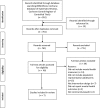Systematic review of mental health and well-being outcomes following community-based obesity prevention interventions among adolescents
- PMID: 25564145
- PMCID: PMC4289720
- DOI: 10.1136/bmjopen-2014-006586
Systematic review of mental health and well-being outcomes following community-based obesity prevention interventions among adolescents
Abstract
Objectives: This paper aimed to systematically evaluate the mental health and well-being outcomes observed in previous community-based obesity prevention interventions in adolescent populations.
Setting: Systematic review of literature from database inception to October 2014. Articles were sourced from CINAHL, Global Health, Health Source: Nursing and Academic Edition, MEDLINE, PsycARTICLES and PsycINFO, all of which were accessed through EBSCOhost. The Cochrane Database was also searched to identify all eligible articles. PRISMA guidelines were followed and search terms and search strategy ensured all possible studies were identified for review.
Participants: Intervention studies were eligible for inclusion if they were: focused on overweight or obesity prevention, community-based, targeted adolescents (aged 10-19 years), reported a mental health or well-being measure, and included a comparison or control group. Studies that focused on specific adolescent groups or were treatment interventions were excluded from review. Quality of evidence was assessed using the Grading of Recommendations, Assessment, Development and Evaluation (GRADE) guidelines.
Primary and secondary outcome measures: Primary outcomes were measures of mental health and well-being, including diagnostic and symptomatic measures. Secondary outcomes included adiposity or weight-related measures.
Results: Seven studies met the inclusion criteria; one reported anxiety/depressive outcomes, two reported on self-perception well-being measures such as self-esteem and self-efficacy, and four studies reported outcomes of quality of life. Positive mental health outcomes demonstrated that following obesity prevention, interventions included a decrease in anxiety and improved health-related quality of life. Quality of evidence was graded as very low.
Conclusions: Although positive outcomes for mental health and well-being do exist, controlled evaluations of community-based obesity prevention interventions have not often included mental health measures (n=7). It is recommended that future interventions incorporate mental health and well-being measures to identify any potential mechanisms influencing adolescent weight-related outcomes, and equally to ensure interventions are not causing harm to adolescent mental health.
Keywords: MENTAL HEALTH; PREVENTIVE MEDICINE; PUBLIC HEALTH.
Published by the BMJ Publishing Group Limited. For permission to use (where not already granted under a licence) please go to http://group.bmj.com/group/rights-licensing/permissions.
Figures


References
-
- Kumanyika SK, Obarzanek E, Stettler N et al. . Population-based prevention of obesity: the need for comprehensive promotion of healthful eating, physical activity, and energy balance: a scientific statement from American Heart Association Council on Epidemiology and Prevention, Interdisciplinary Committee for Prevention (formerly the expert panel on population and prevention science). Circulation 2008;118:428–64. 10.1161/CIRCULATIONAHA.108.189702 - DOI - PubMed
-
- DeMattia L, Denney SL. Childhood obesity prevention: successful community-based efforts. Ann Am Acad Polit Soc Sci 2008;615:83–99. 10.1177/0002716207309940 - DOI
Publication types
MeSH terms
Grants and funding
LinkOut - more resources
Full Text Sources
Other Literature Sources
Medical
Miscellaneous
